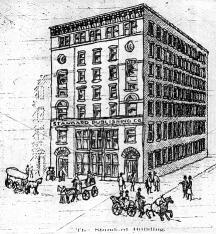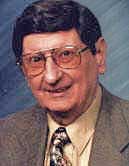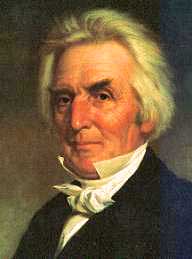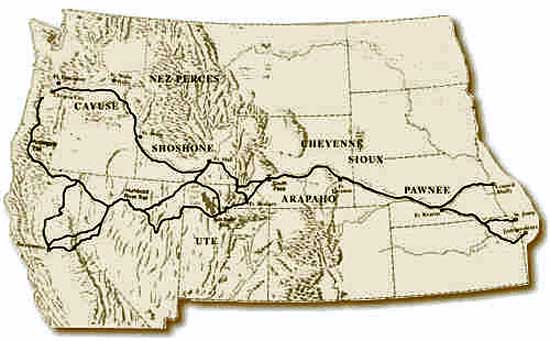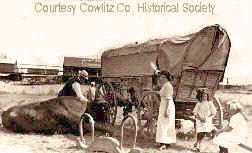 - FIRST THINGS - Interactive Crossword Puzzle |
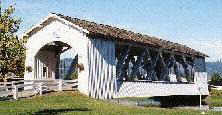 |
Our Resources | The Photos | Three Streams | Influential Men Story of the Four Braves | 1st the Preachers | The Onward March
Next Chapter . . . Pioneer Menu . . . Search
The photo above is the Weddle Bridge, now located in a park at Sweet Home, Oregon. It reminds us of David D. Weddle, Oregon preacher of the pioneer era. It also reminds us that our pioneer past serves as a bridge to the present.
Our Resources
This is an ongoing, correctable, expandable early history of the Restoration Movement in Oregon and the Northwest. It is being written while we travel, preach, and teach at Northwest College of the Bible. We have used Making Disciples in Oregon by Dr. Clarence Frank (Pop) Swander (1874-1959) as a framework and resource. The online version is indexed to these pages. Some of his material, in turn, was drawn from work done by Helen Mae Mick, a 1926 graduate of Eugene Bible University.
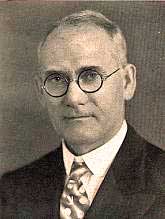
Historian C. F. Swander
about 1928Chapter Seven of Making Disciples in Oregon is a part of this web site.In 2002, additional notes were incorporated from the work of Charles Addleman, Executive Secretary of the Oregon Christian Missionary Society. His book, Oregon Christian Church - A History was published in 1969 by Your Town Press in Salem, Oregon.From the a capella view we have the work of Claude A. Guild and O.J. Russell, and the superb work of Jerry Rushford: Christians on the Oregon Trail. Additionally, we have personally inspected many of the sites and interviewed descendants and other informed people. Libraries and historical societies have yielded much early day writing and a few photos.
Church records for these years are scanty. Churches often do not keep good records for posterity. Information must be gleaned from minutes, memories and museums. C. F. Swander observes charitably that "Disciples have always been too busy making history to record it."
(EDITOR'S COMMENT: If a congregation wants to extend their example beyond their own time, they need to keep meaningful records and provide copies where they can be read by those outside of the congregation. Libraries and historical societies provide this service. Many congregations have disappeared without leaving any written record for posterity.)
An important source of information for these years has been the Christian Record, published in Indianapolis, Indiana and edited by James Mathis and Elijah Goodwin.
Elijah
GoodwinThe Record was very popular in pioneer Oregon because it carried news of "the folks back home." It was published from 1843-1874 and is available on microfilm. The index is available on-line.
Standard Publishing Company Artistic touch-up by Amy Kubow Due to the kindness of Sam Stone, editor of the Christian Standard, published in Cincinnati, Ohio and David McWhirter of the Disciples of Christ Historical Society in Nashville, we were able to examine about 25 years' of the Christian Standard on microfilm.
This proved to be a reliable source of information on events in the northwest, especially after the states were linked by rail.
The drawing at right was taken from the 1892 edition of the Christian Standard.
Additional resources we have used include:
-- the Millennial Harbinger, published by Alexander Campbell.
-- The Christian Messenger and the Pacific Christian Messenger on microfilm at Western Oregon University in Monmouth, Oregon.
-- The Northwest Tribune, pulblished at Colfax, Washington and archived in the Spokane City Library.
-- Two excellent Internet search engines for Restoration Literature are on line, Jim McMillan's and Dr. Hans Rollmann's, as well as our own.This writer is a member of the Disciples Historical Society. The Christian Record and the Christian Messenger indexes are online. Local site search engines: Jim McMillan's and Hans Rollmann's, and our own.The Donation Land Claim Records have been a valuable source for research because the claimant's date of birth, his wife's name, the date they were married, where they came from, when they arrived in Oregon or Washington and the names of three of their friends are on the record. While the Donation Land Claim Law was not signed into law until 1850, pioneers were claiming and recording their claims as early as 1843.
Rather than use footnotes, available documention is in the HTML code that writes the pages. Any browser has provision for reading the coding.
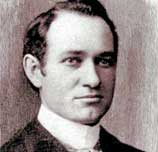
John T. Brown An excellent source of photos has been the engravings in Churches of Christ by John Thomas Brown, published in 1904. The northwest entries of Mr. Brown's volume are online and indexed to these pages.
A portion of Mr. Browns's book is available on our site.The entire text is being brought on line at: www.mun.ca/rels/restmov/texts/jtbrown/coc/COC00.HTM
Using Web search engines, we have searched the World Wide Web for meaningful background information. Readers wanting to submit materials (or corrections) for consideration, e-mail Charles Dailey: Charles@CharlesDailey.net.
As the reader progresses through the story of these gospel preachers, note how many of the preachers and their wives had Biblical names. It says something for the homes they came from. This practice of naming children differs sharply with the current practice of naming children after entertainment idols.
We have included the date of birth and the date of death where this is known. In many cases the dates have come directly from the tombstone or photos of the tombstone.
Many friends in the great northwest have been searching for photos for these pages. We owe them a debt for both information and the one-of-a-kind photos that are displayed here.
The Photos
Our photos are largely black and white because our sources are black and white. Many are from 100 year-old books, historical societies, government archives or even private collections. In some instances we have colorized artist's drawings like the one from Holley.
After having been digitized, many of the photos have been retouched on the computer and skin tones added such as J.V. Crawford's. Sometimes an individual has been lifted from a group photograph like Neal Cheetham.
Power poles and even trees have been removed from building photos so we can show them as they were first built. Later construction additions have been removed like Myrtle Creek.
Blur and other defects have been removed by software like the 1910 Centralia building. Some of these photos are better than their original copy. Our goal in every case has been to present the person or property as we believe it was in the time-frame under discussion.
It has long been a curiosity why almost no one smiled in pictures made a hundred years ago. An article from a historical society cleared this up. The pioneers had little access to dentistry and so their teeth were uneven and missing. As a result, they kept their mouths closed when being photographed.
In at least one case, dentistry consisted of laying the patient on the floor with a knee in their stomach and pulling offending teeth with forceps. Not even Tylenol had been invented. You were just expected to be a man (or a woman). Going to the dentist was not so much a case of courage as it was choosing the lesser of two evils - ongoing pain or momentary pain. How blest we should feel as we enjoy (?) the dentistís profession and how we should thank God that we live in a time when we can smile for our photos.
Three Main Streams
The Restoration Movement, as we use it, refers to that movement among individuals and churches to model the church of today after the model of the first century church. The movement was strong in the United States, particularly on the "Western Frontier" in the early 1800's.
Churches were called Churches of Christ and some who used the musical instruments were also called Christian Churches. The movement has divided into several main streams: Those who use a structure higher than the congregation and are usually called Disciples of Christ (including NW Disciples and Oregon Disciples); those who reject control from above and are known as Churches of Christ and Christian Churches; and those who object to the use of piano, organ or any instruments in the church assembly are known uniformly as Churches of Christ. For brevity, we will refer to the groups as Disciples, Independents and a capella.The Disciples of Christ home page. The home page of the Northwest Disciple. The home page of the Oregon Disciples of Christ. A central listing of Churches of Christ - mostly a capella.Among the Disciples is the growing conservative movement Disciple Heritage with its own publication, its own National Conference and its own covenanted fellowship of Disciple (and former Disciples) churches.
Disciple Heritage home page.For a wealth of information on the Stone/Campbell Restoration Movement in general, visit the work of Dr. Hans Rollmann at the University of Newfoundland and the work of Dr. Jim McMillan.
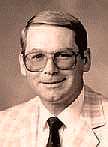
Jim McMillan Dr. Rollman's site. Dr. McMillan's site .This writer's view that instruments such as the piano are Biblical to use in church is set forth in his treatise A Scriptural Analysis of Music in Worship. Also located there are links to the opposing views of Alexander Campbell and Batsell Barrett Baxter.
A Scriptural Analysis of Music in Worship
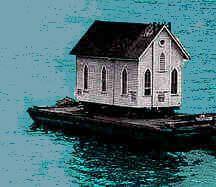
Some churches are drifting A characteristic of the congregations a century ago was their uniformity in teaching that, since Jesus' resurrection, believers'immersion was a requirement to be saved. (This was disclosed by Peter immediately after the resurrection in Acts 2:38.) Not all congregations are as firm on this point today as evidenced by the drift to the broader Evangelical community where the greater emphasis is on the death of Christ rather than His resurrection. The Promise Keepers movement is a case in point. Some congregations are drifting from their historical teachings.
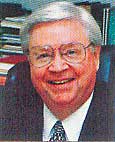
Victor Knowles Currently, there is a concerted effort across the U.S. and in other countries to increase the level of cooperation between the segments of the Stone/Campbell Restoration Movement. Notable is the work of One Body magazine, edited by Victor Knowles.
William E. Paul
College Press has published Taking a Stand, the Story of the Ottumwa Brethren by Victor Knowles and William E. Paul. It details the contributions of this movement to the growth of the Restoration Movement.
Learn more about Taking a Stand. Mr. Paul has translated the New Testament and this is now online.
It is not our design to omit any Restoration group from this brief history. As new material is submitted, we will add it - providing we can do so legally. Publishing on the Internet allows us to link to other sites that offer rich background and we take advantage of that where possible. There is very little history of the a capella congregations in Oregon prior to World War II. Where information has been available, we have included it.
Three Influential Men
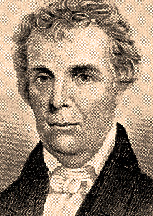
B.W. Stone Three preachers that never saw the Rocky Mountains had a life-changing influence on the pioneers who crossed them. They were Barton Warren Stone, John Mulkey, Sr. and Alexander Campbell. The first two men moved listeners with their preaching and conveyed their enthusiasm for the simple church of the New Testament. Campbell appealed to the intellectual side and his influence is seen in the number of early Oregon preachers that attended Bethany College in Bethany, West Virginia.
We have a photo link about Bethany.
A. Campbell Men influenced by Stone directly included John Newton Stone, a relative who moved to Umatilla County and John Foster who settled in Clackamas County. There is a possibility that Foster named the church he established after Stone and the nearby community took the name, too.
A biographical sketch of Barton Warren Stone is available from Dr. McMillan's site.Mulkey was the son of Baptist preacher Jonathon Mulkey. He began preaching in East Tennessee in 1793 in his 20th year. In 1809 he changed his mind about "unconditional election," raising the ire of the Baptist community. That year he and a few other Baptist preachers decided to leave off creeds and take only the Bible. They reorganized their churches to be "Christian only." That same year and without knowledge of events in Tennessee, Thomas Campbell wrote his Declaration and Address in Pennsylvania. God was moving men. John Mulkey preached 10,000 sermons over 51 years of ministry and was a major influence among the men coming west to evangelize the Oregon Territory.
We have much more about John Mulkey in his profile.A number of Mulkeys came west, settling in Oregon. Philip, son of John Sr., settled in Lane County. Philip's nephew, Isaac Newton Mulkey, moved about the state, preaching. Aaron preached in Clackamas County and young John H. Mulkey settled in Douglas County. Preacher Thomas Crawford McBride was a member of the same Stockton Valley Baptist Association as John Mulkey, Sr. and lived near Mulkey. Thomas came west and is buried in Yamhill County.
We have a profile of Thomas Crawford McBride.Years after the Mulkey Movement began in Kentucky and Tennessee, Alexander Campbell came to the same views on his own, not knowing of the Stones and the Mulkeys. Key Oregon church leaders later attended or graduated from Bethany College in West Virginia after studying under the scholarly Campbell.
Bethany College home page.The majority of Bethany men went into college teaching when they came west. The Mulkey men did more of the face-to-face work in gospel meetings and church planting.
Here is a partial list of Bethany men and when they arrived:
William Lysander Adams (1848) profile
Teacher at Blackhawk School
Trustee of Bethel College
Editor of the Oregon Argus
Thomas Franklin Campbell (1852) profile
Preacher
President of Christian College
Editor of the Christian Messenger
Candidate for Governor
James C. Campbell (1871)
Grandson of Thomas Campbell
Teacher at Christian College
Associate editor of the Christian Messenger
William Mason (1852)
(Was professor at Bethany)
Trustee at Christian College
William Thompson Haley (1857)
Professor at Christian College and Bethel
Levi Lindsay Rowland (1858) profile
Preacher
President of Bethel College
President of Christian College
State Superintent of Public Instruction
Charles Hubbell Hodges (1872)
Teacher at Neah Bay, WA.
Teacher and preacher at Columbia City
Teacher at Glencoe
Preacher at Shady Brook
John W. Jenkins (1880) profile
Preacher at Hood River, The Dalles, Athena
R. M. Messick (1889)
Preacher in East Portland, held numerous meetings.
John Rigdon (1852) profile
Circuit riding preacher in Oregon and Washington
(His choice of ministry may have been related to his declining eyesight)
David Truman Stanley (1876)
President of Monmouth University
Editor of the Christian MessengerStory of the Four Braves
Elements of this story surfaced frequently in the literature of mid-1800's. It is reported by the highly regarded Hubert Howe Bancroft, (The History of Oregon, page 54) who cites many historical sources of his time. He acknowledges slight variations in the story, but believes that it substantially correct. We reproduce it here in full detail from the Oregon Christian Church - a History by Charles Addleman.
The story begins with the Indians in the mountains of the Pacific Northwest in 1832 who had heard from the trappers about a white man's "Book of Heaven." As a result, some of the braves made the long journey to St. Louis seeking the book.The story of this search is summed up in these words: "We came to you over a trail of many moons from the setting sun. You are the friend of our fathers who have all come a long way. We came with our eyes partly open for more light for our people who sit in darkness. We go back with our eyes closed. How can we go back with our eyes blind to our blind people? We made our way to you with strong arms, through many enemies in strange lands that we might carry back much to them. We go back with empty and broken arms.
The two fathers who came with us -- the braves of many winters and wars -- we leave them here asleep by your great wigwam. They were tired in their journey of many moons. Our people sent us to get the white man's book of Heaven. You took us to where they worshiped the great spirit with candles but the book was not there. You showed us the image of good spirits and pictures of the good land beyond, but the book was not among them to tell us the way. You made our feet heavy with the burdens of gifts and our moccasins will grow old with the carrying of them, but the book is not among them.
We're going back the long, sad trail to our people. When we tell them, after one more snow and the big council that we did not bring the book, no word will be spoken by our old men or by our young braves. One by one they will rise up and go out in silence. Our people will die in darkness and they will go on the long path to their other hunting grounds . No white man will go with them and no book of Heaven to make the way plain. We have no more words."
Even though two of the braves died in St. Louis and the other two sadly returned to the Northwest, the story was published in a newspaper, and Jason Lee, a recently ordained minister in the Methodist church, read the newspaper report and responded to the challenge.
First Came the Preachers
C.F. Swander, quoting Harvey Scott, the editor of the Morning Oregonian says:
"It was not until the American missionaries entered and possessed the country that a foothold was gained for the occupation of Oregon by American settlers."Civilization ended at Independence, Missouri in 1843. Jason Lee had seen the possibilities of the Oregon Territory for the United States and had convinced President Van Buren to aid settlers coming west. The aid was in the form of one square mile of Oregon or Washington - 640 acres for a married couple.
See the statue and story of Jason Lee.The first large emigrant train was forming in the spring. This was a mass movement of people with Independence, Missouri as the jump-off point. James Pritchard wrote:
"The Emigrants were encamped in every direction for miles around the place awaiting the time to come for their departure."
The Oregon and California Trails. Prepared by NPR The following provisions were advised for each adult going to Oregon: 150 pounds of flour, 15 pounds of coffee, 25 pounds of bacon, 25 pounds of sugar, a quantity of yeast for bread making, salt and pepper.
Roadometer There were 875 men, women and children and 200 white-topped prairie schooners in the emigrant train that completed the five month trek from Independence 1843. Wagons covered about 15 miles each day.
Some of the wagons were equipped with a "roadometer" on a back wheel so mileage numbers were precise. The device had a capacity for measuring up to 10 miles, so had to be reset at least once each day.
The train was led by Dr. Marcus Whitman and sometimes called the "Great Migration."
The names of the 1843 emigrants are now online.Jesse Applegate said in 1843,
The Prairie Schooner
"No other race of men with the means at their command would undertake so great a journey, none save these could successfully perform it, with no previous preparation, relying only on the fertility of their own invention to devise the means to overcome each danger and difficulty as it arose. They have undertaken to perform with slow-moving oxen a journey of two thousand miles. The way lies over trackless wastes, wide and deep rivers, ragged and lofty mountains and is beset with hostile savages."
Trail life was harsh. One of every 17 adults died making the trip and one of every five children was buried beside the trail.

Preparing to leave Independence, Missouri At the time of the new arrivals, there were less than 200 Americans in Oregon. Click here for a list of their names. Some of the emigrants must have been from Restoration churches because, as the preachers arrived two years later, the disciples were already in Oregon.
Stephenie Flora has listed the names of those in Oregon Territory before the first migration. She has arranged general information about the Trail.
Pioneer Reminder: We recommend The End of the Oregon Trail Interpretive Center at Oregon City as an excellent presentation to give a personal feeling of the Trail experience. It is an outstanding value.
See The End of the Oregon Trail Interpretive Center web site.The reader may want to consider the CD Rom entitled The Oregon Trail Pioneer Adventures from the Learning Company.
One company that sells it is listed here.Some later emigrants, to avoid the dangers of the Oregon Trail, chose the Applegate Trail through Nevada.
A link to an Applegate Trail site.
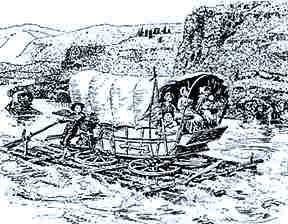 |
The most serious challenge for those entering the Willamette Valley before the Barlow Road was opened was the rapids on the Columbia River. For the final 50 miles, it was necessary to put the wagons on rafts to get to Fort Vancouver or Oregon City. Many prairie schooners were lost and even many lives were lost so close to their destination.
The next year, in 1844, 1,400 people started for Oregon in covered wagons. In the caravan of 1845 (3,000 people) were two Restoration preachers and a number of other disciples.
Amos Harvey (1799-1877) settled on the banks of the Yamhill River and organized a congregation in his home March 17, 1846. (This section is being written exactly 150 years later, to the day!) John Foster settled on the Clackamas River and brought scattered disciples together in a church near Carver, Oregon.
There is a profile of Amos Harvey.In the emigrant train of 1846 (1,500 people) came Glen Owen Burnett (1809-1886), brother of Peter H. Burnett, who became the first governor of California. The brothers had married sisters, Sarah and Harriet. Glen Owen Burnett settled in Polk County and later was a founder of the Bethel Church and Bethel College.
There is a profile of Glen Burnett.Glen Burnett's four year old son Peter R. Burnett (1842-1922) was also in the emigrant train with his parents and was destined to mature and become a very powerful proclaimer of the gospel of the risen Jesus. Educated at Hesperian College in Woodland, California, he is credited with baptizing more than 2,000 men, women and young people into Christ during his life of service.
We have a profile of Peter Rogers Burnett.
Elijah Bristow (1788-1872) was also in the 1846 migration. He arrived by way of a stop in California. He settled in Lane county and was one of the founders of the Pleasant Hill Church.
At least some of the wagon trains had bylaws. Here is a sample:
Oaktown townshipThe clan settled in the Irving area near Eugene and were members of the Grand Prairie Church.
Knox County, Indiana
March 1, 1853
Bylaws of the McClure Clan over the Oregon Trail.
All persons desiring to emigrate to the Oregon Territory in the wagon train now being assembled, will be required to subscribe to the bylaws adopted by the company.Section 1: The officers of this company shall consist of a Captain and a lieutenant. The duties of the Captain will be to have full charge of the movement of the train, and his orders must be obeyed by every member subscribing to these bylaws. The lieutenant will execute the orders of the Captain, and in case of sickness or disability of the Captain, will have full charge of the Company.
Section 2: The Captain may call council meetings when he deems it necessary, and each member of the company will have the opportunity of expressing his or her views on the subject for which the council was called. When all have spoken, the question is voted upon. In case of a tie vote, the Captain will cast the deciding vote.
Section 3: The destination of this company is the fertile valley of the Willamette, located between the Cascade Mountains on the east and the Coast range on the west. Upon arrival at the end of the journey, and when a suitable place is located upon which to establish homes, age will take precedence. The oldest will have first choice of the land and so on down the line to the youngest member of the company to hold a claim. The same procedure also to apply to the erection of a habitation.
Section 4: When each freeholder in the company has made a selection of land and has a cabin erected on same, then a meeting of the council will be called and the bylaws having been fulfilled the company will disband and the bylaws be of no further force or effect.
Officers: Vincent S. McClure, Captain
James F. McClure, LieutenantSigned:
Vincent S. McClure and wife Sallie
James F. McClure and wife Nancy
William Bond and wife Hetty
Allen Bond and wife Rachael
David C. Bruce, single man
Andrew S. McClure, single man
Taken from Journey over the Oregon Trail by William and Hetty Bond, 1853 and transcribed by Lincoln Shadley in 1961. The document was made available to us through the courtesy of Donna Wells of Redmond, Oregon.The Onward March
O.J. Russell writes about this period in Oregon History:
It is of profound significance that a large percent of the early settlers and missionaries were Christians only. Oregon was being settled at the time that the principles of restored Christianity were sweeping the country and citadels denominationalism were falling under the onward march of New Testament Christians. In Virginia, Ohio, Kentucky, Tennessee, the Carolinas, Illinois and many Eastern and Southern states, Campbell, Stone, Smith, Walter Scott and a host of others were baptizing thousands and were impressing men in every station of life with the simple appeal of New Testament Christianity.
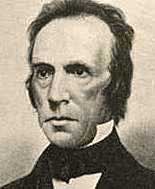
Walter Scott Henry Clay, Abraham Lincoln and scores of other statesmen were impressed with the plea to restore the church to the world just as it existed in the first century. In fact, when Alexander Campbell debated for sixteen days, N. L. Rice, the noted Presbyterian debater, Henry Clay served as president for the moderators.
The message of these "reformers" ("restoration" had not been used yet) was not to unite with any Christian movement that would have them. Alexander Campbell sounded the clarion call before the General Missionary Convention when he said so forcibly, "Our mission is as much to sectarianism as it is to sinnerdom; as much to call saints out of Babylon as sinners out of Satandom."
Quoted by Alex Johnson in the Christian Standard of January 10, 1885.These pioneer preachers in America laid down a platform that would cut men loose from everything having a human creed and urged men to go back to the beginning; "speaking where the Bible speaks and being silent where the Bible is silent." They believed there should be but one church over which Christ ruled as head and that denominationalism was a curse and a sin. All matters in religion were to be solved by an appeal to the New Testament.
Deaths and Some Resurrections
Numerous churches were planted that died within a few years and we cannot even locate the towns where they held forth the light. They served their purpose and went out of existance as people moved to other employment. Mining and the timber industry illustrate this.An added reason communities have gone out of existance and churches have closed has been the automobile. Floyd Mullen observes:
In early days, a store and post office pair were usually located seven or eight miles apart. This was about the right distance to travel in one day by oxcart over rut-filled roads. As roads were improved, and new ones developed, many of the early trading centers vanished.
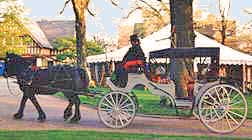
Following the oxcart came the horse and buggy and, in about 1910, autos made their appearance. Pictured below is a 1912 Model T. This swift new form of transportation changed church life in two ways. It brought about the demise of some congregations. When it was no longer necessary to have an acreage for the horses during church, it became practical to motor to town - and in less time than it took to get to the rural congregation by horse and buggy.
It also slowed the establishing of new rural churches. Instead of a few families getting together at a home or school, those concerned enough simply drove to town to an existing church. Do-it-yourself church planting largely came to an end.
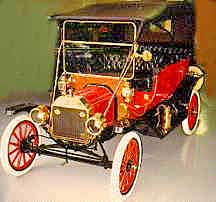
In some cases before autos, churches were planted, died, and resurrected, sometimes several times. The last reincarnation held and the church is active today.
Not all church closings have been disasters. While we tell here of live churches, we shall also mention a few that have closed, leaving an impact on other Restoration churches.
Oregon Christian Church historian Charles Addleman says that 159 congregations were started before 1900.
Next Chapter: Wild Growth or back to Pioneer Menu

